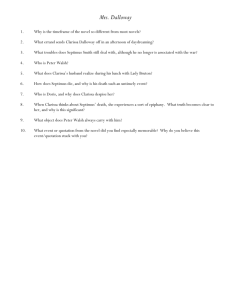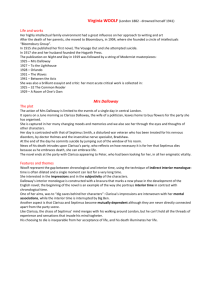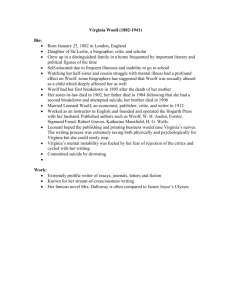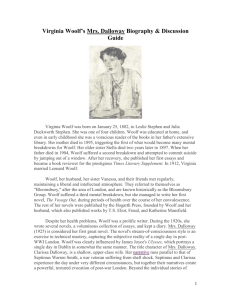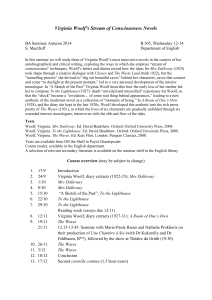the concept of self in virginia woolf's mrs. dalloway
advertisement
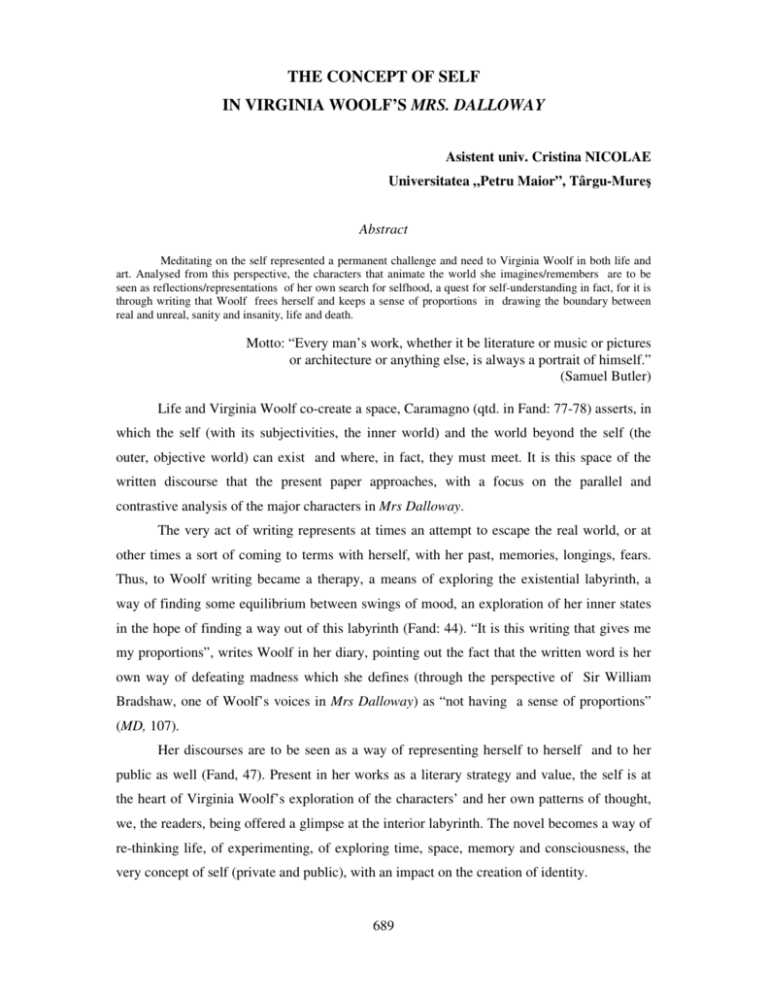
THE CONCEPT OF SELF IN VIRGINIA WOOLF’S MRS. DALLOWAY Asistent univ. Cristina NICOLAE Universitatea „Petru Maior”, Târgu-Mureş Abstract Meditating on the self represented a permanent challenge and need to Virginia Woolf in both life and art. Analysed from this perspective, the characters that animate the world she imagines/remembers are to be seen as reflections/representations of her own search for selfhood, a quest for self-understanding in fact, for it is through writing that Woolf frees herself and keeps a sense of proportions in drawing the boundary between real and unreal, sanity and insanity, life and death. Motto: “Every man’s work, whether it be literature or music or pictures or architecture or anything else, is always a portrait of himself.” (Samuel Butler) Life and Virginia Woolf co-create a space, Caramagno (qtd. in Fand: 77-78) asserts, in which the self (with its subjectivities, the inner world) and the world beyond the self (the outer, objective world) can exist and where, in fact, they must meet. It is this space of the written discourse that the present paper approaches, with a focus on the parallel and contrastive analysis of the major characters in Mrs Dalloway. The very act of writing represents at times an attempt to escape the real world, or at other times a sort of coming to terms with herself, with her past, memories, longings, fears. Thus, to Woolf writing became a therapy, a means of exploring the existential labyrinth, a way of finding some equilibrium between swings of mood, an exploration of her inner states in the hope of finding a way out of this labyrinth (Fand: 44). “It is this writing that gives me my proportions”, writes Woolf in her diary, pointing out the fact that the written word is her own way of defeating madness which she defines (through the perspective of Sir William Bradshaw, one of Woolf’s voices in Mrs Dalloway) as “not having a sense of proportions” (MD, 107). Her discourses are to be seen as a way of representing herself to herself and to her public as well (Fand, 47). Present in her works as a literary strategy and value, the self is at the heart of Virginia Woolf’s exploration of the characters’ and her own patterns of thought, we, the readers, being offered a glimpse at the interior labyrinth. The novel becomes a way of re-thinking life, of experimenting, of exploring time, space, memory and consciousness, the very concept of self (private and public), with an impact on the creation of identity. 689 Roxanne Fand states in her 1999 book, The Dialogic Self: Reconstructing Subjectivity in Woolf, Lessing, and Atwood, that Woolf’s concept of self (in both life and work, we might add) is “dialogic”, and explains her statement by making use of words such as “game”, “shifting centers of interaction”, “boundaries that appear and diappear”, all underlining Woolf’s ability to play with the boundaries of the self, a “dialogic impulse” that brings together the feminine and the masculine and deconstructs the terms of gender by “the convolution of discourses in her characters’ minds” (43-44): Virginia Woolf’s concept of self is dialogic in that it opens up the finite rules of self-narrative to an infinity game in which the selves of the fictional characters become shifing centers of interaction with everything from subtle immediate influences to those far out in time and space. The boundaries between characters and between characters and the nonhuman world appear and diappear in negotiated meanings that are both serious and ironically playful, disrupting conventional monologic self-narratives. (41) Following a different analysis, Allen Derek et al argue that her interest in the way the mind perceives and analyses times and events is also reflected in her understanding of the differences between the minds of men and women: “Basically she felt that the female mind was intuitive and that it could help free the male mind from its dependence on abstract, intellectual notions” (2003:103). Woolf’s ideal was of uniting the masculine and the feminine in an androgynous self, and in her fiction she does that by means of suggesting androginy implicitly (Fand, 41). Jane Goldman (2008: 53) asserts that in Mrs Dalloway women’s identity is seen as circumscribed by men and makes further reference to the theory of androginy (100) as put forward in A Room of One’s Own: It is fatal to be a man or woman pure and simple; one must be woman-manly or man-womanly. It is fatal for a woman to lay the least stress on any grievance; to plead even with justice any cause; in any way to speak consciously as a woman. And fatal is no figure of speech; for anyhing written with that conscious bias is doomed to death. It ceases to be fertilized ... Some collaboration has to take place in the mind between the woman and the man before the art of creation can be accomplished. Some marriage of opposites has to be accomplished. Hence the double narrative, the doubling of Clarissa and Septimus, the two parallel strands being connected not at the event level, but at the level of the reading-process (Beer, 1996: 54), by “a number of the day’s passing events held in common as points of transition between them” (Goldman, 54) and between the different characters’ consciousness, such as: the sound of the closed car backfiring, the aeroplane skywriting, the song of the flowerseller, the sound image of Big Ben striking the hours of the day. And all these are seen as motifs used as unifying devices (Ciocoi-Pop, 2002: 41). In Mrs Dalloway the tale unfolds over the course of one day in June 1923 in London, and the reader is given a description of how this day was experienced by Mrs Dalloway and the other characters. Still, the time involved in “the basic drama” which takes place in the minds of the characters covers 18 years (41). In terms of structure, the novel has no chapters, 690 but there are 12 sections separated by spacing which allows for a fluid unfolding of a double narrative: we, the readers, (“the medium of connection” as Beer emphasizes; 1996: 53) can follow Clarissa as she is preparing for her party, and Septimus and his torment, his way to suicide. According to Ciocoi-Pop, the unities are “superimposed on a narrative which gently lacks them. The function of this dualism”, he further asserts, “is the same as it is in Ulysses: it makes it possible for an outside consciousness (the reader’s) to follow, understand, and interpret the minds of the characters which the author creates.” (41) To Woolf, this idealized identity - the androgyne - implies a continuous process of redefining the inner and outer world/reality, a flux of permanently changing feelings, thoughts, behaviour, bringing forth the human complexity, the different aspects of the self, without destroying them. Woolf’s concept of self and art is based on deconstructing the terms of gender, on disruptions of fixed identities, on the characters’ cutting across boundaries according to their readiness rather than to their sex, the writer bringing together in her fiction the impersonal (egoless state; trancending and integrating subjectivities) and the personal (ego-bound; limited subjectivities) (Fand: 43-44, 47) The loss of ego has different outcomes, Fand asserts, as emotions always oscillate between the two phases mentioned above. On the one hand, there are characters in Woolf’s fiction to which the impersonal, egoless state brings about a feeling of anxiety, of terror and despair as a result of felt powerlessness, of lack of control over “the impersonal universe of chaos”, as she calls it, over time. On the other hand there are characters for whom the egoless state results in a feeling of liberation, of peace. Fallowing Fand’s analysis (48), this ego is strongly related to: a. a “virgin territory”, as Woolf called it, that it/the ego defends, this territory being in fact “the integrity of the characters to enter or maintain an ‘inner sanctuary’ of formlessness”; b.“outer territories” of manifest form (that it still defends) such as one’s body and accomplishments. From one perspective Mrs Dalloway is about bonds (Derek, 104) that tie together either people that know each other (Clarissa and her friends and acquaintances) or people that do not know each other (Clarissa and Warren Septimus Smith). In The Cambridge Companion to the Modernist Novel, it is asserted that Clarissa and Septimus “share what might seem a single consciousness, intense and vulnerable, each fearing to be consumed by a fire perpetually about to break forth.” (Bloom qtd in Jensen, 116), consequently the term ‘double’ would describe precisely this relation between Clarissa (the sane) and Septimus (the insane) that the novel studies. 691 According to Gillian Beer (1996: 54), in Mrs Dalloway “the two selves of gender are parted”: they share no personal history, they never actually meet and never have meet. Still, as the critic further asserts, Woolf manages to bring them together with the help of some points of transition established at the level of the reading process (the reader being seen as the medium of connection, as it has already been emphasised, 53) as they do share a common history/present - the past of the war and of the English social stratification, London - and some events of the day (the closed car, the aeroplane), the party (when Clarissa learns about Septimus’s death and sees it as an attempt to communicate), even their dislike of Sir Bradshaw whom Clarissa instinctively resents, which to some extent makes her identify with Septimus. It is by means of the reader’s analysis that these major characters become one, an analysis of the elements that connect them and which they perceive differently and consequently react to them differently, Woolf succeeding in combining the male and the female in one self by moving from one character to the other, bringing them together, but at the same time keeping them apart. • fear versus ‘fear no more’; failure versus winning/surviving versus dying Both characters are haunted by a recurring verse (Jensen, 116) from Shakespeare’s Cymbeline (Woolf’s “ideal androgynous writer” as stated by Goldman, 101), the reader following its rewritings throughout the novel: “Fear no more the heat o’ the sun’’. They are haunted by the same words, but their reading, understanding of the verse is a different one. On the one hand, for Clarissa the phrase is a comforting one, offering a sense of connection to the collective (Jensen, 117) which helps her to be a survivor. Nevertheless, from a certain perspective she fails as she denies feelings. On the other hand, to Septimus this connection to the world brings about horror, anxiety, madness and thus he fails in terms of survival from a social point of view, but if analysed from the perspective of preserving the private self, he can be seen as a winner as he succeeds in preserving its privacy, unspoiled by the ‘“human nature” which is “on us” (Dr Holmes and Sir Bradshaw – Woolf’s characters: “Once you fall, Septimus repeated to himself, human nature is on you. Holmes and Bradshaw are on you”, MD: 108). The fear of failing to feel conditions his recovery and perception of reality. • suicide: the heart and/or the body Clarissa distinguishes between the heart and the body, while for Septimus there is no such distinction/separation (Jensen, 118). Clarissa’s survival is translated in terms of body, of social interaction, still one might assert that she commits suicide, just as Septimus does, but at the level of feelings as a result of her inability to allow passion in her life, not even for her husband, lacking “something central, which permeated”: 692 Lovely in childhood, suddenly there came a moment [...] when, through some contraction of this cold spirit, she had failed him. And then at Constantinopole, and again and again. She could see what she lacked. It was not beauty; it was not mind. It was something central which permeated; something warm which broke up surfaces and rippled the cold contact of man and woman, or of women together. (MD,36; bolds mine) It is “this coldness, this woodenness, something very profound in her [...]; an impenetrability”, as Peter Walsh defines it (68) that prevents Clarissa from feeling love, passion, thus committing suicide, if one might say so, at the level of heart but not of the body, whereas for Septimus the heart is in the body (“fear no more, says the heart in the body; fear no more”), therefore his suicide is at the level of both heart and body. Life (also implied in the idea of the party) and death are brought together as the man’s death becomes part of Clarissa’s life on the latter hearing about the suicide. • the flames Another device that establishes a bond between the two characters is represented by the flames that they see in moments of sudden revelation, which are, on the one hand, purifying (Clarissa) and, on the other hand, destructive (Septimus) (Jensen; 116-118). • sexuality Septimus has no feelings and comes to blame the world for this, he does not love his wife or feel passion, desire for her, and the awareness of his failure to feel results in panic, “sudden thunder-claps of fear”: “... the appaling fear came over him – he could not feel. He could reason; he could read, Dante for example, quite easily [...], he could add up his bill; his brain was perfect; it must be the fault of the world then – that he could not feel.” (MD, 96, 98) By contrast, the idea of feelings, desire, passion is introduced by characters such as Peter Walsh, Sully Suton, both in relation with Clarissa and her past, and by Doris Kilman (the tutor) as well, in relation with Clarissa’s daughter, Elizabeth. Goldman suggests that the novel has a lesbian subtext. Indeed, Woolf presents Clarissa’s approach to the question of love, of falling in love with women (MD, 36-37) Clarissa kissing and being in love with her friend Sally Suton (the “pure”, “disinterested”, “protective” feeling she had for Sally, MD, 38-39), and also Doris Kilman’s relationship with Elizabeth. It is in this context that the image of the diamond comes to be associated either with Sally and Clarissa, when it is seen as a symbol of “lost lesbian erotics” (Goldman, 55) or just with Clarissa when, in front of the mirror, she “narcissistically defines herself as diamond-like”(55): Sally stopped; picked a flower; kissed her on the lips.[...] And she felt that she had been given a present, wrapped up, and told just to keep it, not to look at it – a diamond, something infinitely precious, wrapped up, which as they walked [...] she uncovered, or the radiance burnt through, the revelation, the religious feeling! (MD, 40) That was her self when some effort, some call on her to be her self, drew the parts together, she alone knew how different, how incompatible and composed so for the world only into one centre, one diamond, one woman who 693 sat in her drawing-room and made a meeting-point, a radiancy no doubt in some dull lives, a refuge for the lonely to come to, perhaps. (MD, 42) • the act of creation In both life and art, Virginia Woolf perceives the act of creation as a means of defying madness and coping with reality. In Mrs Dalloway, creation and communication are brought together, both in connection with the soundness of mind, the ability of distinguishing the real from the unreal, of “having a sense of proportions”. Therefore, analysed from the perspective of one’s search for selfhood, writing becomes (to Virginia Woolf) a defining way of creating and sharing, of re-analysing and coming to terms with the past. And again: “It is this writing that gives me my proportions”. Following the same analysis, the very idea of party-giving implies for Clarissa Dalloway creating and sharing reality (Ruotolo, 115), an attempt to communicate in fact, perceived as a means of survival. Hawthorn (1975: 37) adds a very interesting approach here, stating that parties involve vulnerability, risk and an offering, enabling Clarissa to “regenarate her sense of identity through the development of relationships based on openness and honesty”. Septimus Warren Smith, writes notes which he refuses to share (they have to be hidden or destroyed). In his case the act of writing is not meant to communicate, it represents the failure to create a bond that would tie together the individual and the others, but at the same time, it represents the individual’s attempt to preserve the self unspoiled by the others. Another element worth mentioning here is the hat that his wife creates, Septimus eventually taking part in this process of artistic creation. The hat that is to be given as a present symbolizes an act of offering, sharing, communicating, signaling his coming back to reality, to sanity, Septimus gradually allowing himself to rediscover/see (on opening his eyes) the real. But communication fails again as dr Holmes (“the human nature”) corners him; it is precisely this feeling of being trapped that makes him commit suicide (although “life was good”, as he says to himself right before throwing himself out of the window). According to Julia Briggs (2005:146) “Septimus’s experiences are the only record we have of what Woolf’s illness felt like from the inside”, echoing “moments from her earlier fiction”. Therefore writing about this character’s madness means in fact rewriting madness, as Briggs states, and (to some extent) re-living/re-experiencing this traumatic part of the novelist’s personal history. Character creation emerges as a reflection/representation of one’s self. Finally Clarissa imagines Septimus’s suicide as an attempt to communicate: “Death was defiance. Death was an attempt to communicate, people feeling the impossibility of 694 reaching the centre which, mystically, evaded them; closeness drew apart; rapture faded; one was alone. There was an embrace in death.” (MD: 202) • the individual versus the group; communication and self-exposure; shutting oneself off Septimus rejects this relationship between the individual and the group, he fears it, he does not want it as he perceives it as a threat that would result in the loss of ego. Communication is feared as he fears self-exposure (Hawthorn, 34) and loss of his sense of identity; consequently he shuts himself off from the world in order to preserve the (private) self. Clarissa seeks this relationship, wants it, enjoys it, depends on it. But, as Hawthorn underlines “it is possible that in shutting herself off from Peter Walsh, Clarissa may have caused the death of her soul.” (35) She fears the loss of self (34), hence her inability to give herself to Peter Walsh or Richard as to her an embrace/abandonment to passion implies precisely giving up one’s self. Her parties are to be seen as an offering, compensating for the shutting off from Richard and Peter, from love but not from life. And thus Mrs Dalloway could be seen as a novel about life and death, about the life and death of the body versus the soul understood in terms of privacy, the others, and alienation, a novel about the survival of the self, about understanding and keeping a subjective and/or objective understanding of proportions. Mrs Dalloway is a novel about the concept of self, of identity itself, be it the characters’ or the writer’s. BIBLIOGRAPHY Beer, Gillian (1996) Virginia Woolf: The Common Ground: Essays by Gillian Beer, The Univeristy of Michigan Press, Ann Arbor Briggs, Julia (2005). Virginia Woolf: An Inner Life, Allen Lane Ciocoi-Pop, Dumitru (2002) Highlights of Modern British Literature. Sibiu: Editura Universitatii “Lucian Blaga” pp 37-46 Derek, Allen et al. (2003) Words Words Words. A History and Anthology of Literatures in English, La Spiga Languages, Volume III: The 20th Century Literatures in English: 102-113 Fand, Roxanne J. (1999) The Dialogic Self: Reconstructing Subjectivity in Woolf, Lessing, and Atwood, Selinsgrove, PA: Susquehanna University Press, www. questia.com, consulted on 18 May 2009 pp 41-91 Goldman, Jane (2008) The Cambridge Introduction to Virginia Woolf. Cambridge University Press Hawthorn, Jeremy (1975) Virginia Woolf’s Mrs Dalloway. A Study in Alienation. Sussex University Press Ruotolo, Lucio P. (1986) The Interrupted Moment. A View of Virginia Woolf’s Novels, Stanford: Stanford University Press Jensen, Meg “Tradition and Revelation: Moments of Being in Virginia Woolf’s Major Novels” in Shiach, Morag (ed.) (2007) The Cambridge Companion to the Modernist Novel. Cambridge University Press Woolf, Virginia (1996), Mrs Dalloway, London: Penguin Books, abbreviated here to MD 695
